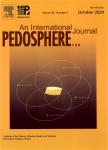Denitrification Losses and N_2O Emissions from Nitrogen Fertilizer Applied to a Vegetable Field
Denitrification Losses and N_2O Emissions from Nitrogen Fertilizer Applied to a Vegetable Field作者机构:State Key laboratory of Soil and Sustainable Agriculture Institute of Soil Science Chinese Academy of Sciences Nanjing 210008 (China) Graduate School of the Chinese Academy of Sciences Beijing 100039 (China) Institute of Plant Nutrition and Resources Beijing Academy of Agricultural and Forestry Sciences Beijing 100089 (China)
出 版 物:《Pedosphere》 (土壤圈(英文版))
年 卷 期:2006年第16卷第3期
页 面:390-397页
核心收录:
学科分类:09[农学] 0902[农学-园艺学] 090202[农学-蔬菜学]
主 题:denitrification loss N2O emission polymer-coated urea urea vegetable field
摘 要:A field experiment was conducted on Chinese cabbage (Brassica campestris L. ssp. pekinensis (Lour.) Olsson) in a Nanjing suburb in 2003. The experiment included 4 treatments in a randomized complete block design with 3 replicates: zero chemical fertilizer N (CK); urea at rates of 300 kg N ha^-1 (U300) and 600 kg N ha^-1 (U600), both as basal and two topdressings; and polymer-coated urea at a rate of 180 kg N ha^-1 (PCU180) as a basal application. The acetylene inhibition technique was used to measure denitrification (N2 + N2O) from intact soil cores and N2O emissions in the absence of acetylene. Results showed that compared to (3K total denitrification losses were significantly greater (P ≤ 0.05) in the PCU180, U300, and U600 treatments,while N2O emissions in the U300 and U600 treatments were significantly higher (P ≤ 0.05) than (3K. In the U300 and U600 treatments peaks of denitrification and N2O emission were usually observed after N application. In the polymer-coated urea treatment (PCU180) during the period 20 to 40 days after transplanting, higher denitrification rates and N2O fluxes occurred. Compared with urea, polymer-coated urea did not show any effect on reducing denitrification losses and N2O emissions in terms of percentage of applied N. As temperature gradually decreased from transplanting to harvest, denitrification rates and N2O emissions tended to decrease. A significant (P ≤0.01) positive correlation occurred between denitrification (r = 0.872) or N2O emission (r = 0.781) flux densities and soil temperature in the CK treatment with a stable nitrate content during the whole growing season.



